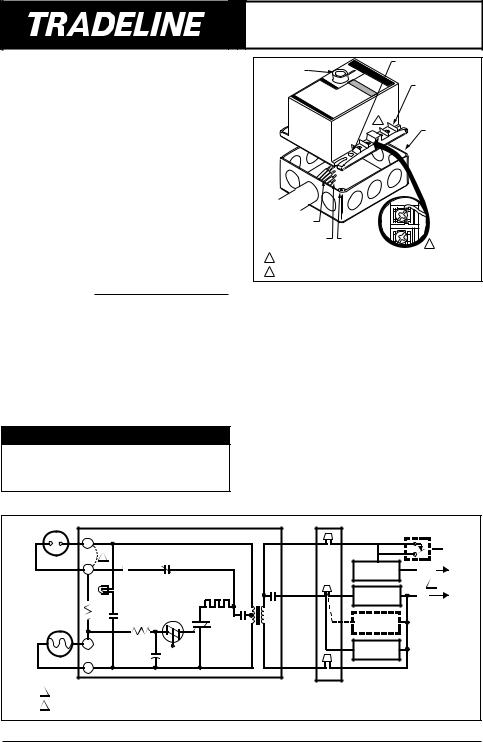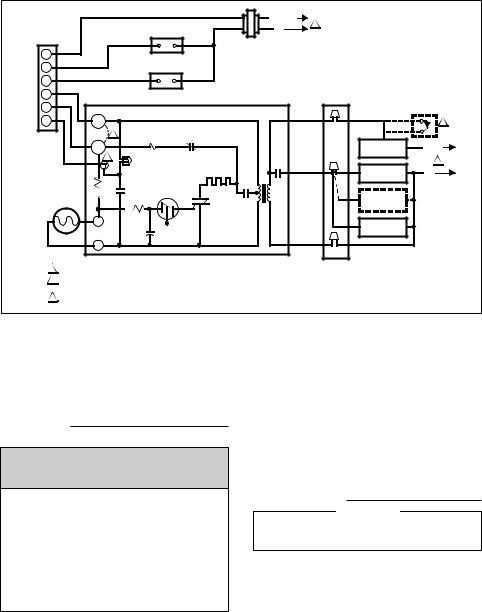Honeywell R8184G User Manual

R8184G PROTECTORELAY |
OIL PRIMARY |
APPLICATION
The TRADELINE intermittent ignition oil primary control operates the oil burner, oil valve (if desired) and the ignition transformer in response to a call for heat from the thermostat. Through a C554 Cad Cell Flame Sensor, the R8184 monitors the burner flame and shuts down the system on ignition failure or on flame failure during the run cycle. A light emitting diode (LED) on the terminal strip lights when the safety switch opens to provide safety shutdown indication. A manual reset button is provided to reset the safety switch after lockout.
For convenience in system maintenance, the safety switch can be manually opened using a lever on the front of the control. Clock thermostats that power the clock through the primary control transformer will lose time during lockout unless backup batteries are installed.
R8184G is component recognized by Underwriters Laboratories Inc. and meets their flammability test requirements for a final enclosure.
RED RESET |
HOLE OR KNOCKOUT FOR |
BUTTON |
CAD CELL LEADS |
|
LOW VOLTAGE |
|
TERMINAL STRIP |
|
2 |
|
4 x 4 JUNCTION |
|
BOX |
CAD |
|
|
CELL LEADS |
|
|
LINE |
MOUNTING |
|
VOLTAGE LEADS |
1 |
|
|
SCREW HOLE |
1 STRIP WIRES 3/8 in. (9.5 mm); INSERT FROM SIDE, ABOVE OR BELOW.
2 T-T TERMINALS ON R8184G; T1-T2 TERMINALS ON R8184N. M1643B
INSTALLATION
WHEN INSTALLING THIS PRODUCT…
1.Read these instructions carefully. Failure to follow them could damage the product or cause a hazardous condition.
2.Check the ratings given in the instructions and on the product to make sure the product is suitable for your application.
3.Installer must be a trained, experienced service technician.
4.After installation is complete, check out product operation as provided in these instructions.
CAUTION
1.Disconnect power before beginning installation to prevent electrical shock or equipment damage.
2.Make sure combustion chamber is free of oil or vapor before starting system.
Fig. 1—Mounting the R8184G controls with 130° F [54° C] maximum ambient temprature.
LOCATION
1.Mount on a 4 x 4 inch junction box, directly on the main burner, or inside the appliance cabinet. In replacement applications, mount in the same location as the old control.
2.Ensure the operating temperatures are within the ambient temperature range. Ambient temperature ranges are either -40° to 130° F [-40° C to 54° C] or -40° F to 150° F [-40° C to 66° C] (Refer to box label).
MAKE WIRING CONNECTIONS AND MOUNT CONTROL
Wiring must comply with all local codes and ordinances. Before mounting the control, make line voltage connections as shown in Fig. 1 or 2. Splice leads with solderless connectors. Do not exceed load ratings shown on the device
label.
If cad cell leads are run with line voltage wires, breakout knockout at the bottom of the low voltage terminal strip and thread can cell leads through the hole.
If necessary use control as a template to mark and drill new mounting holes. Mount using No. 6 screws (obtain locally).
THERMOSTAT |
R8184G PROTECTORELAY CONTROL |
|
|
JUNCTION BOX |
|
LINE VOLTAGE |
||
|
|
|
|
|
|
|
||
|
|
|
|
|
|
BLACK |
|
THERMOSTAT |
|
T |
|
|
|
|
|
2 |
|
|
|
|
|
|
|
|
||
|
2 |
|
SAFETY |
|
|
|
|
|
|
1K |
SWITCH |
|
|
|
|
|
|
|
|
|
|
|
|
L1 |
||
|
T |
|
|
|
|
|
LIMIT |
|
|
|
|
|
|
|
(HOT) |
||
|
|
|
|
|
|
|
||
|
|
|
SAFETY |
|
|
|
|
|
|
|
LOCKOUT |
|
|
|
|
1 |
|
|
|
SWITCH |
|
1K2 |
ORANGE |
|
||
|
|
INDICATOR |
|
BURNER |
|
|||
|
|
HEATER |
|
|
L2 |
|||
|
|
LED |
|
|
|
|||
|
|
|
|
|
|
MOTOR |
||
|
|
|
|
|
|
|
|
|
|
R1 |
SAFETY |
BILATERAL |
|
|
|
|
|
|
|
SWITCH |
SWITCH |
1K1 |
|
|
OIL VALVE |
|
CAD CELL |
|
|
TRIAC |
|
|
(OPTIONAL) |
|
|
|
F |
R2 |
|
|
|
|
|
|
|
|
|
|
|
|
IGNITION |
|
|
|
|
|
CAPACITOR |
|
|
|
|
|
|
|
|
|
|
WHITE |
|
|
|
|
F |
|
|
|
|
|
|
|
|
|
|
|
|
|
|
|
|
1 POWER SUPPLY. PROVIDE DISCONNECT MEANS AND OVERLOAD PROTECTION AS REQUIRED.
2 TO USE R8184 WITH LINE VOLTAGE CONTROLLER, JUMPER T-T TERMINALS AND CONNECT LINE VOLTAGE THERMOSTAT IN
SERIES WITH LIMIT CONTROLLER.
M1635
Fig. 2—Typical hookup for TRADELINE R8184G with indicator light.
D.T. |
Form Number 69-0617—1 |
Rev. 4-91 |
© Honeywell Inc. 1991 |

|
|
L1 (HOT) |
|
FAN |
1 |
|
L2 |
|
|
RELAY |
|
|
|
|
T87F/Q539A |
|
COOLING |
|
|
|
RC |
|
TRANSFORMER |
COOLING |
|
|
G |
|
|
CONTROL |
|
Y
RH |
R8184G PROTECTORELAY CONTROL |
|
JUNCTION BOX |
|
|
|||
W |
|
|
LINE VOLTAGE |
|||||
|
|
|
|
|
|
|
THERMOSTAT |
|
|
|
|
|
|
|
BLACK |
|
|
X |
T(R) |
|
|
|
|
|
2 |
|
|
|
|
|
|
|
|||
|
|
|
|
|
|
|
|
|
|
|
2 |
SAFETY |
|
|
|
|
|
|
|
SWITCH |
|
|
|
|
|
|
|
|
1K |
|
|
|
|
L1 |
|
|
|
|
|
|
|
|
||
|
T(W) |
|
|
|
|
|
LIMIT |
|
|
|
|
|
|
|
(HOT) |
||
|
|
|
|
|
|
|
||
|
3 |
|
|
|
|
|
|
|
|
LOCKOUT |
SAFETY |
|
|
|
1 |
||
|
|
INDICATOR |
SWITCH |
1K2 |
ORANGE |
|
||
|
VIOLET |
BURNER |
|
|||||
|
LED |
|
HEATER |
|
L2 |
|||
|
|
|
|
|
MOTOR |
|||
|
|
|
|
|
|
|
|
|
|
R1 |
SAFETY |
BILATERAL |
|
|
|
|
|
|
|
SWITCH |
SWITCH |
|
|
|
OIL VALVE |
|
|
|
|
|
TRIAC 1K1 |
|
|
|
|
|
CAD CELL |
|
|
|
|
(OPTIONAL) |
|
|
|
F |
R2 |
|
|
|
|
|
|
|
|
|
|
|
|
IGNITION |
|
|
|
|
|
CAPACITOR |
|
|
|
|
|
|
|
|
|
|
WHITE |
|
|
|
|
F |
|
|
|
|
|
|
|
|
|
|
|
|
|
|
|
|
1POWER SUPPLY. PROVIDE DISCONNECT MEANS AND OVERLOAD PROTECTION AS REQUIRED.
2TO USE R8184 WITH LINE VOLTAGE CONTROLLER, JUMPER T-T TERMINALS AND CONNECT LINE VOLTAGE THERMOSTAT IN SERIES WITH LIMIT CONTROLLER.
3 REMOVE PLUG AND ROUTE VIOLET LEADWIRE THROUGH HOLE IN BASE OF R8184. |
M718 |
Fig. 3—Typical hookup for Tradeline R8184G with indicator light and isolated alarm relay.
Mount control as shown in Fig. 1 or 2. After mounting, make low voltage connections to the screw terminals. Strip leads 3/8 in. [10 mm] and insert under terminal screw. See Fig. 1 or 2. Connect cad cell leads to F-F terminals and thermostat leads to T-T terminals. See Fig. 3 or 4.
CHECKOUT
START SYSTEM
WARNING
Fire hazard.
Can cause severe burns.
Make sure combustion chamber is free of oil or oil vapor before starting system.
1.Push in and release red reset button.
2.Open hand valve in oil supply line.
3.Make sure system is powered. Check circuit breaker or fuse and close system switch, if provided.
4.Set thermostat to call for heat.
5.Burner should light and operate until call for heat ends.
CHECK SAFETY FEATURES
Simulate flame failure:
1.Follow starting procedure to turn on burner.
2.Close hand valve in oil supply line.
3.Safety switch should lock out approximately in safety switch timing indicated on label. Indicator light should come on. Ignition and motor should stop and oil valve should close.
Simulate ignition failure:
1.Follow starting procedure to turn on burner, except do not open oil supply hand valve.
2.Safety switch should lock out in safety switch timing (see label). Indicator light should come on. Ignition and motor should stop and oil valve should close.
Simulate power failure:
1.Follow starting procedure to turn on burner.
2.With burner running, trip circuit breaker or remove fuse to turn off power to the system.
3.Burner should stop.
4.Restore power. Burner should restart.
If system does not operate as described, proceed to Troubleshooting.
TROUBLESHOOTING AND
MAINTENANCE
IMPORTANT
This control contains no field-serviceable parts. Do not attempt to take it apart. Replace entire control if operation is not as described.
PRELIMINARY STEPS
1.Check wiring connections and power supply. Make sure power is on to the controls, burner motor, and ignition transformer.
2.Make sure limit control is closed.
CHECK OIL PRIMARY RELAY
NOTE: You’ll need an insulated jumper wire with both ends stripped.
1.Disconnect cad cell leads from F-F terminals.
2.Reset safety switch and set thermostat to call for heat. Burner should start.
3.Within safety switch timing, jumper F-F terminals with insulated jumper wire. Burner should continue to run.
4.After safety switch timing, remove jumper. Burner should shut down in safety switch timing.
5.If operation is not as described, replace oil primary control.
2
